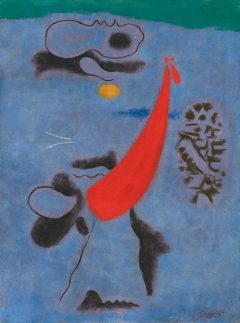Wilhelm Lehmbruck
Kleine Sinnende
1910/1911

Plaster, ochre tinted, patinated
53.2 cm / 20 15/16 in
Signed on the plinth
One of approx. 12 copies of this version (cast in 1920), which were sold through the Galerie Tannenbaum in Mannheim and the Kunstsalon Ludwig Schames in Frankfurt / Main; According to the Catalogue Raisonné, further lifetime and posthumous casts of this work in varying techniques are to be found in the collections of the following museums: Wilhelm Lehmbruck Museum in Duisburg, Kunstmuseum Moritzburg in Halle (Saale), Angermuseum Erfurt, Kunsthalle Mannheim, The Art Institute of Chicago, Detroit Institute of Arts, Bayerische Staatsgemäldesammlungen, Rheinisches Landesmuseum in Bonn, St. Louis Art Museum, Sprengel Museum Hannover, Tel Aviv Museum of Art, Landesmuseum Mainz, Kröller-Möller Museum in Otterloo, Lindenau-Museum in Altenburg, Philadelphia Museum, Buffalo AKG Art Museum and the Wilhelm-Hack Museum Ludwigshafen
Catalogue Raisonné by Schubert 2001 no. 55 C. a. 7.
Private Collection Switzerland; Galerie Ludorff, Dusseldorf (1991); Private Collection Mannheim (1991-2024)
- Galerie Ludorff, "Neuerwerbungen Frühjahr 2024", Düsseldorf 2023
- Kunsthalle Mannheim, "Private Passions. Sammeln in Mannheim", 27. Okt. 2011 - 26. Feb. 2012, Mannheim
- Galerie Ludorff, "Skulptur 2", Düsseldorf 2025
- Galerie Ludorff, "Neuerwerbungen Frühjahr 2024", Düsseldorf 2024, S. 74
- Ulrike Lorenz/Inge Herold (Hg.), "Private Passions. Sammeln in Mannheim", Ausst.-Kat. Kunsthalle Mannheim, Berlin 2011
- Dietrich Schubert, "Wilhelm Lehmbruck. Catalogue raisonné der Skulpturen 1898-1919", Worms 2001, Nr. 55 C. a. 7.
- Galerie Ludorff, "Skulptur 2", Düsseldorf 2025
The sculpture "Kleine Sinnende" by Wilhelm Lehmbruck, created in 1910, impressively embodies the central ideas of German Expressionism and the early 20th century. Lehmbruck, one of the most important sculptors of his time, created a masterpiece with this work that impresses with its formal innovation and emotional depth.
It depicts a young, female figure who appears to be immersed in a meditative pose. Lehmbruck has given the sculpture a particularly soft, delicate surface, which bathes the forms in a diffuse light. The reduction to the essentials and the focus on emotional expressiveness make the sculpture an outstanding example of Expressionism.
Stucco was deliberately chosen as the material for the casting of this sculpture, as it can be individually refined with a patina after the casting process to further enhance the expression. Further rubbing and patination creates a very special, timeless elegance. The fine details, especially in the facial expression, allow the viewer to immerse themselves in the inner emotional world of the figure. It is this subtle balance between abstraction and naturalism that makes the sculpture a milestone in modern sculpture.
The figure's pose radiates a quiet contemplation that represents the search for inner truth and spiritual experience - a characteristic feature of expressionist art. Lehmbruck overcomes conventional depictions and expresses a universal humanity through the subtle nuances of the sculpture. The "Kleine Sinnende" is also remarkable in its spatial design. The sculpture seems to unfold in the space, creating a dialogue between the figure and its counterpart. Lehmbruck uses the space around the sculpture to create an immersive experience that involves the viewer in the emotional content of the work.
Overall, the "Kleine Sinnende" represents a high point in German sculpture. The sculpture combines formal innovation, emotional intensity and a timeless spiritual dimension. Its influence on the development of modern sculpture is undeniable and makes it a significant work in the context of early 20th century art history.







